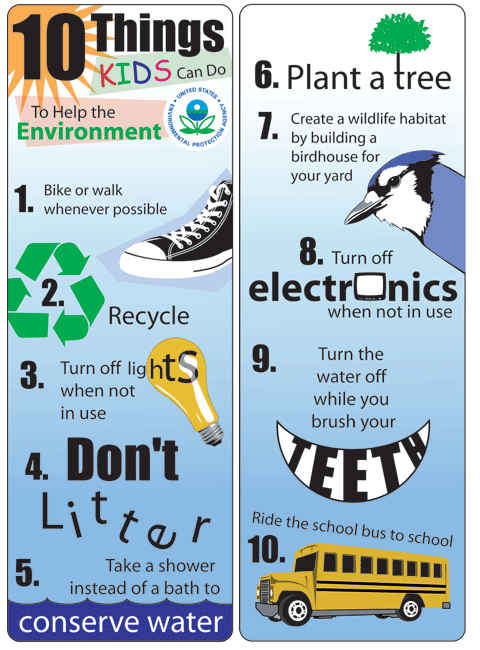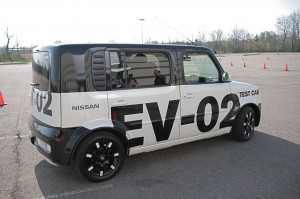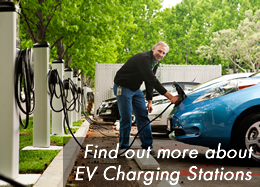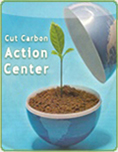Call
Call your Volunteer Center. This is a place that can help you find volunteer projects. To find a Volunteer Center near you, visit this Web site or call 1-800-VOLUNTEER. Then ask an adult to help you call. Tell them your age and ask if there are ways that you can help the environment.
Read
Project for a Healthy Planet: Simple Environmental Experiments for Kids
By Shar Levine and Allison Grafton
Jossey-Bass
Projects to help kids understand the causes of pollution and find ways to protect the environment.
Recycle! A Handbook for Kids
By Gail Gibbons
Little, Brown & Company
Explains the process of recycling from start to finish.
Where Does the Garbage Go?
By Paul Showers
HarperTrophy
Shows how people create waste and how this waste can be recycled or end up in a landfill.
Dinosaurs to the Rescue: A Guide to Protecting Our Planet
By Laurie Krasny Brown & Marc Brown
Little, Brown & Company
The creators of Arthur suggest many ways that young children can protect the Earth.
Fernando’s Gift
By Douglas Keister
Sierra Club
You can read this book in English and Spanish. Find out what Fernando and Carmina, children who live in the rainforest of Costa Rica, do when Carmina’s favorite tree is cut down.
I Want to Be an Environmentalist
By Stephanie Maze
Harcourt
Meet people—such as botanists, economists, organic farmers, biologists, and scuba divers—who work to protect the Earth.
Kid Heroes of the Environment: Simple Things Real Kids Are Doing to Save the Earth
Catherine Dee, Ed.
Earth Works Press
Read about what kids across the country are doing to help the environment. Find out what steps to take to complete a volunteer project and get contact information for environmental organizations.
The Lorax
By Dr. Seuss
Random House
The Once-ler greedily chops down the Truffula Tree tufts to make Thneeds. Will he listen to the Lorax’s warnings before all of the trees are gone?
Links
Meet the GREENS
Watch original cartoon adventures with THE GREENS and play related green games. Here you’ll discover news, downloads, a blog, action tips, links, and much more.
Earth 911
Type in your zip code and get information about environmental programs in your community.
The Big Gift for the Rain Forest
Learn how you can protect an acre of the rain forest.
Kids Make a Difference
Learn how you can make a difference by planting trees.
Kids’ Planet
Tell political leaders how you feel about protecting wildlife.
Tree Musketeers
Join an organization run by kids! You, too, can become a Tree Musketeer and plant trees while learning about the environment.
Plant a Tree
Here’s how you can plant a tree:
1. First decide when to plant your tree. Carbon Day is Held each year on Sept 15.
2. Now decide where to plant your tree. You can plant your tree in your backyard with your family. Or you can ask your teacher if there is a place to plant it at school.
3. Buy your tree. For $10 you can join the National Arbor Day Foundation and receive ten trees in the mail. Ask an adult to help you sign up and order your trees. You can also buy a tree from your local nursery (a place that grows trees and other plants). Ask a person who works at the nursery to help you choose a tree that will grow well in your area.
4. Prepare your tree for planting. If you ordered a tree through the mail, it will have bare roots. Unpack the tree and soak the roots in water for 3 to 6 hours. If you bought a tree at a nursery, ask someone there for planting instructions.
5. Plant your tree. Dig a hole that is just as deep as and about twice as wide as the roots. Place the tree in the hole and hold it upright while a friend fills the hole with dirt. Pack down the dirt. Give your tree plenty of water.
6. Spread a layer of mulch about two inches deep around your tree but not touching it. (You can buy mulch at a nursery.) Mulch helps keep your tree from drying up.
7. Water your tree often over the next year and watch it grow!
8. Think about it:
· Who did your project help?
· What did you see and hear during the project?
· How did this project make you feel?
· What did you learn that you did not know before?
· What new questions or ideas do you have?
· Is there anything you would do differently the next time?
9. Celebrate! Thank everyone who helped you. And remember to REGISTER YOUR TREE ON CARBONDAY.COM
10. Keep helping. There are plenty of other ways to help the environment. Get your classmates or your after school program to adopt a park to keep clean. You can go back every month and have a contest to see who can pick up the most trash in half an hour.
Practice 3 Rs: Reduce, Reuse, Recycle
Practice the three Rs of conservation: reduce, reuse, recycle. Here are some ideas to get you started.
- Reduce: Use Only What You Need! Here are some easy ways for you to help reduce the trash you create and save natural resources.
· Use fewer grocery bags! Bring your own cloth bags to the grocery store when you shop. Or bring back the plastic or paper bags you got the last time.
· Check it out. Look for and buy products that have less packaging. But if something you really need comes with packaging (like bottles or cardboard boxes), try to reuse or recycle it.
· Water matters. Make an effort to use less water. Figure out how much water you usually use to take a shower by trying the Shower Estimation activity. Then come up with ways to use less water like turning off the shower as you wash your hair. You could also ask your parents to install low-flow showerheads or turn off the water while you brush your teeth.
· Turn it off. Use less electricity so there’s less air pollution. Climb the stairs instead of using the elevator. Turn off the lights, TV, and computer when you’re not using them.
- Reuse! Here’s a great way to make less waste:
· Be creative and reuse! Find a second use for trash. Use old newspapers to makeRecycled Paper. Use this paper to make cards to write let. Make a Junk Picture Frame out of cardboard, buttons, and other small pieces of trash.
- Recycle! Whenever possible, give an item a second life! Here are some great ways to recycle:
· Buy recycled products. Ask your family or school to use recycled paper and other products. When you buy recycled products, the message is clear–you want to protect the environment.
· Be helpful. Does your town have a recycling center? If so, encourage your family and neighbors to recycle. Paper, plastics, aluminum cans, and glass can all be recycled. If your community or school doesn’t have curbside pick-up or a recycling program, write to your elected officials about starting one. (Visit the links at the bottom of the page to learn how.)
· Hailey and her girl scout troop in Florida planted trees in a neighborhood park to celebrate Carbon Day. Carbon Day is a holiday to encourage people to plant trees. Trees produce oxygen for us to breathe, remove pollution from the air, and provide food and shelter for wildlife.
Videos
Start your own clean-up project
Here’s how to start your own clean-up project:
- Think of a place that is important to you. It might be a bus stop near your house, your school playground, a nearby beach, or any other place where you like to spend time.
- What can you do to help your favorite place look its best? You could pick up trash, remove weeds, add a coat of paint, or donate plants.
- Get permission. Get permission before you make big changes, like planting, weeding, or painting. Ask an adult to help you call a city official or the site owner. For example, if you are planting a tree in a park, you should contact the Department of Public Works.
- Tell your friends and family. Tell your friends and family about your project and ask if they want to help. Find a day when your helpers will be free.
- Collect supplies. Collect clean-up supplies like gloves, trash bags, paper towels, and glass cleaner. Don’t forget to make a Mechanical Grabber (pdf: 475k, Adobe Acrobat required)
- Let the clean-up begin! Make sure to bring an adult with you. When your clean-up day arrives, make your favorite place look its best. Take “before” and “after” photos to send to ZOOM.
- Safety first. Don’t pick up any sharp objects, such as broken glass. If you find something sharp, ask an adult to take care of it for you.
- Wait before you throw! If you find any recyclable items like cans or paper bags, don’t throw them out! Bring them to your local recycling center instead!
- Think about it.
· Who did your clean-up help?
· What did you see and hear during the clean-up?
· How did the clean-up make you feel?
· What did you learn that you did not know before?
· What new questions or ideas do you have?
· Is there anything you would do differently the next time?
- Celebrate! Thank everyone who helped you. If you took pictures, you can send some to the friends and family members who volunteered with you. And remember to log your hours and share your story.
- Keep helping. Go back to your area once a month to keep it clean. Write a letter to your local newspaper and tell them about your project. Tell them why this place is special to you and what people can do to help take care of it. Remember to send your “before” and “after” pictures, too.
What You Can Do To Help The Environment
Green Construction
Retro-Fit with Carbon Day
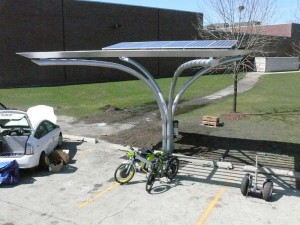
Carbon Day has partnered with Empact Developmentwhich is a full-service construction firm dedicated to
the construction of new buildings and retro-fit of existing buildings using environmentally friendly and sustainable materials which will help erase or neutralize any building’s carbon footprint. Our construction and retro-fit program will provide our clients a “Green” approach to operate their assets while benefiting from energy cost savings.
Green Construction has a vast impact on the natural environment, human health, and the economy. By adopting green building strategies, we can maximize both economic and environmental performance. Green construction methods can be integrated into buildings at any stage, from design and construction, to renovation and deconstruction. However, the most significant benefits can be obtained if the design and construction team takes an integrated approach from the earliest stages of a building project.
Green construction is Evidence of a growing trend toward green building design and sustainable living is springing up all over Chicago, we are here to take full advantage of all the opportunities out there. Empact Development has created strategic partnerships with LEED accredited architects, third party authorized certified agents in conjunction with the USGBC, interior designers, landscape architects, manufactures, suppliers, In house project managers, and infinite amount of insured and qualified contractors who only practice Green Construction. We also have a procurement arm for all recyclable and green material/furniture. Empact has hired a grant writing team for our clients to enjoy the tax credits and subsidies on a federal, state, and city level. So not only improve the quality of life for your home and or business, improve your bottom line and enjoy the benefits that are out there for going “GREEN”
Retro-Fit Benefits:
To Owners and Tenants:
- Lower Utility Bills
- Healthier living and work environment
- Reduced Maintenance Cost
- Increase Properties Appreciation
- Increase Resale Value
- Beneficial Mortgage Programs
To Local Municipality:
- Strengthen community programs
- Demonstrate Environmental Leadership
- Preservation of Local Quality of Life
To Builders:
- Lower Waist Removal Cost
- Reduce amount of use of materials
- Increased Marketing potential
To the Environment:
- Greenhouse Gas Reduction
- Improved Water Quality
- Improved Air Quality
- Decreased Carbon Footprint
Steps to Success
- Establish a vision that embraces sustainable principles and an integrated design approach.
- Develop a clear statement of the project’s vision, goals, design criteria, and priorities.
- Develop a project budget that covers green building measures. Allocate contingencies for additional research and analysis of specific options.
- Seek sponsorship or grant opportunities.
- Seek advice of our design professional with green building experience and implement schematic drawings.
- Select a design/build team that is committed to the project vision. Modify the RFQ/RFP selection process to ensure the contractors have appropriate qualifications to identify, select, and implement an integrated system of green building measures.
- Develop a project schedule that allows for systems testing and commissioning.
- Develop contract plans and specifications to ensure that the building design is at a suitable level of building performance.
- Create effective incentives and oversight.
Green building measures cannot achieve their goals unless they work as intended. Building commissioning includes testing and adjusting the mechanical, electrical, and plumbing systems to ensure that all equipment meets design criteria. It also includes instructing the staff on the operation and maintenance of equipment. Over time, building performance can be assured through measurement, adjustment, and upgrading. Proper maintenance ensures that a building continues to perform as designed and commissioned.
- Green Applications
- Solar Applications
- Wind Turbines
- Energy efficient low wattage lighting and lighting design
- Radiant heat
- Tank-less on demand water heaters
- Geo-Thermal Heating
- Green Construction Options
- Recyclable countertops
- Water efficient plumbing fixtures
- High efficiency, Star Rated HVAC systems
- Recyclable insulation
- LOW VOC paint
- Sustainable flooring systems
- Energy Star rated appliances
Please Contact
Elliot Offenbach
800 W Huron Suite 4E
Chicago, IL 60642Direct: 847-977-9929
ElliotO@CarbonDay.com
Nissan’s $1.1 billion loan likely to be approved by DOE
The DOE loan that Nissan applied for to help it build electric cars and advanced batteries is likely to be approved for $1.1 billion, according to a report that cited “unidentified sources” in Kyodo News. The loan will probably speed up Nissan’s already fast-moving electric car program that is moving forward across the globe. Some of the U.S. city and state governments that are working with Nissan on EVs include Raleigh, Phoenix, Tucson, California; Tennessee; and Seattle. The DOE money would be used to upgrade the company’s Smyrna, Tenn., assembly plant and build a new facility for battery production.
The loan would come from the Advanced Technology Vehicle Manufacturing Incentive Program (AVTM) fund, a $25 billion pot that the DOE set aside to help automakers get more efficient vehicles to market. Green Car Advisor says that Nissan is also asking the Development Bank of Japan for another $1.1 billion loan and has already borrowed half that much from the Japanese government.
http://www.autobloggreen.com/2009/05/28/nissans-1-1-billion-loan-likely-to-be-approved-by-doe/

